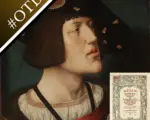
On this day in Tudor history, 6th June, Holy Roman Emperor Charles V made a grand entry into London with Henry VIII; the Prayer Book rebels assembled at Bodmin; and musician and conspirator William Hunnis died…
[Read More...]
On this day in Tudor history, 6th June, Holy Roman Emperor Charles V made a grand entry into London with Henry VIII; the Prayer Book rebels assembled at Bodmin; and musician and conspirator William Hunnis died…
[Read More...]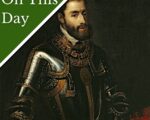
On this day in Tudor history, 21st September 1558, in the reign of Queen Mary I, Mary’s cousin and father-in-law, Charles V, former Holy Roman Emperor, died from malaria at the monastery of Yuste in the Extremadura region of Spain.
Charles had previously been suffering from debilitating attacks of gout which had necessitated him being carried around in a chair.
He was buried at the monastery church, but later moved to the Royal Pantheon of El Escorial, the Royal Palace at San Lorenzo de El Escorial near Madrid.
[Read More...]
On this day in Tudor history, 24th February 1603, Katherine Howard (née Carey), Countess of Nottingham, died at Arundel House.
Katherine was a close friend of Queen Elizabeth I and it is thought that grief over her friend’s death had a major impact on the queen’s own health, for she died just a month later.
Find out who Katherine was, how she rose to be the queen’s good friend, and also hear about a myth associated with her in this talk…
[Read More...]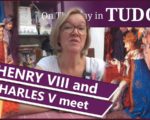
On this day in Tudor history, 26th May 1520, in the lead-up to King Henry VIII’s meeting with Francis I of France at the Field of Cloth of Gold, the English king met with his nephew Charles V, Holy Roman Emperor, at Dover Castle on the south coast of England.
Find out more about this meeting and the rather lavish outfits worn by Henry VIII and his queen consort, Catherine of Aragon, in today’s talk.
[Read More...]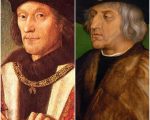
Carrying on from my recent Claire Chats talk on proxy marriages, I just wanted to look at the negotiations for a marriage between Mary Tudor, daughter of King Henry VII, and Charles of Castile (later Charles V, Holy Roman Emperor), and the end result, a ceremony that took place in December 1508.
What’s interesting is that the service in 1508 was different to what had actually been agreed between Henry VII and Emperor Maximilian. Let me explain…
[Read More...]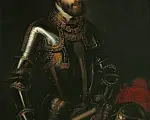
On this day in Tudor history, 6th June 1522, Holy Roman Emperor Charles V and King Henry VIII made a grand entry into the city of London.
Now these two rulers did not just enter the city with music and cheering, they did it in style with pageantry – 9 spectacular pageants in all! The Tudors really knew how to celebrate!
Find out more about the pageants in today’s video.
[Read More...]
On this day in Tudor history, 24 February 1500, a man who would be heir to three powerful dynasties and who would rule “the empire on which the sun never sets” was born. That man was Charles V, Holy Roman Emperor.
In today’s video, I share some Charles V facts. He was an interesting man!
[Read More...]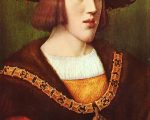
On this day in history, 6th June 1522, Charles V, Holy Roman Emperor and the nephew of King Henry VIII’s wife, Catherine of Aragon, made a grand entry into the city of London. He was accompanied by King Henry VIII.
Three years ago, I did a Claire Chats video talk on Charles V’s 1522 visit to England, and here it is:
[Read More...]
On this day in history, 6th June 1522, Charles V, the Holy Roman Emperor, made a grand entry into London accompanied by King Henry VIII.
You can read two primary source accounts of Charles’s entry, and the pageantry involved, in the chronicles of Edward Hall and Charles Wriothesley at the following links
[Read More...]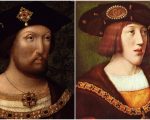
On 26th May 1520, King Henry VIII met with Charles V, Holy Roman Emperor, at Dover Castle on the south coast of England.
Here is an account of this event from chronicler Edward Hall:
“The king intending and perseveryng in purpose to mete with Frances the Frenche kyng, greate and riche provisions were made, wherfore the noble Kyng and the Quene with all the noble courte removed the twentie and one daie of May beyng on Mundaie, from their maner of Grenewyche towardes the Sea side, and so on the Fridaie beeyng the twentie and five daie of May, arrived at the citee of Canterbury, intendyng there to kepe his Pentecoste.
Sone after whiche commyng to Cantorbury, tidynges wer brought that Charles Emperor electe, was on the sea, in sight of the coast of England, wherfore officers of the kyng were sent with great diligence to the Castle and toune of Dover to be there in a redines against the arrival of the Emperor.
[Read More...]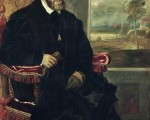
This is Part III of a four-part series, which seeks to look at what were considered the attributes of a Renaissance prince, and who of our four princes embodied the ideals of the Renaissance best. What were some of those themes? The idea of a Renaissance man stood for a person who strove to embrace knowledge and develop himself. This included concepts such as the arts, knowledge, physical achievements, and social ideals. More plainly and for a prince, this could include cultivating a court known for patronising artists, musicians, and the like; establishing educational institutions, a good degree of physical fortitude, and things such as chivalric love or engaging in acts of charity.
[Read More...]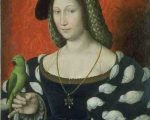
On 24 February 1525, the Battle of Pavia was fought as part of the Italian Wars that began in 1521 and ended in 1526. The French troops, led by King Francis I, fought against the Holy Roman Emperor Charles V’s Imperial army, which was reinforced by Spanish troops. The battle lasted around four hours, with the French taking heavy casualties. Francis himself was taken captive and eventually forced to sign the Treaty of Madrid. It also decisively removed the French threat to Hapsburg Italy.
[Read More...]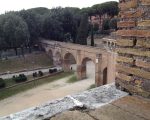
6 May 1527. Pope Clement VII had been sitting on St. Peter’s Chair since 19 November 1523. An illegitimate member of the Medici clan, he was raised by his uncle Lorenzo de’ Medici, known as Lorenzo the Magnificent. His cousin was Pope Leo X, second son of Lorenzo the Magnificent and another Medici. Clement VII was originally trained for military service but showed a great interest in serving the clergy. Though it was traditional for illegitimate sons to be blocked from holding a bishopric, Clement VII’s cousin Leo X elevated him anyway, setting the stage for Clement VII to eventually become pope. Unfortunately, Clement VII proved to be an ineffective statesman and was caught between the powerful leaders of France, the Holy Roman Empire, and England: Francis I, Charles V and Henry VIII, respectively. This being caught between a rock and a hard place would set the stage for Rome to be overrun and defiled.
[Read More...]
In today’s Claire Chat’s video I talk about the visit Charles V made to England in 1522, to make an alliance with Henry VIII against France, and all the pageantry and entertainment that he enjoyed.
[Read More...]